Jenštejn Castle
Jenštejn Castle is a castle ruin in the village of Jenštejn (German: Jenstein, also Jenzenstein or Genzenstein) in the district of Prague-east in the Central Bohemian Region. The small town of Jenštejn was founded with a small, water-protected castle in the first half of the 14th century by Jenc of Janovice (from here the name “jenc´s stone“ = "Jencenstein"), a high-ranking official in court yard, in 1336–1361. Lords of Jenštejn[1] have their family name from the name of the castle. Since 1958 it has been protected as a cultural monument of the Czech Republic.[2] The castle was opened to the public after the reconstruction in 1977.[3] Today is the castle is under the wooden frame, but still open for people. In the castle it is possible to find an exhibition of the Regional Museum of Prague-East about life in the castle with period paintings and a model of the castle. The castle tower surpasses the surrounding plain and is used as a lookout tower over the local landscape.
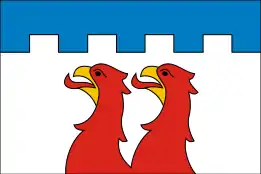
| Jenštejn castle | |
|---|---|
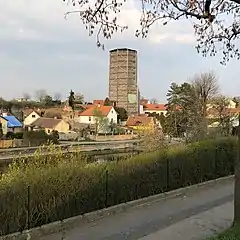 | |
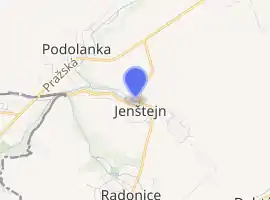
| |
| General information | |
| Status | ruin |
| Type | castle, view point, museum |
| Architectural style | Gothic |
| Town or city | Jenštejn |
| Country | Czech Republic |
| Coordinates | 50°09′12″N 14°36′40″E |
| Completed | 30s of the 14th century |
| Renovated | 1977 |
| Destroyed | 1940 |
| Height | 28-meter-high |
| Design and construction | |
| Architect | Jenc of Janovice |
History
The first mention of the Jenštejn Castle dates back to 1341, when it was owned by Jenc of Janovice, probably its builder. It is believed that it was founded sometime in the thirties of the 14th century. Only the lower part of the tower was preserved From this period of the castle, consisting of regular ashlar and adjacent walls. In 1368, the royal chamber notary Pavel of Vlašim bought the castle. This branch of the family soon became a family from Jenštejn (they also took over the coat of arms - two vulture heads). Pavel z Vlašimi, the brother of Prague Archbishop Jan Očko of Vlašim, began to write (in the middle of the 14th century) as Paul of Jenštejn (“Paulus de Jenczenstein”). Pavel of Jenštejn had four childs: Martin, Pavel, Jan and Václav and everyone also used a nickname “from Jenštejn“. Jan became the third Prague archbishop in 1380 after his uncle Jan Očko of Vlašim. before he became the Archbishop of Prague, he spent his youth at Jenštejn and inherited the castle after death of his brother Martin. During his lifetime he made extensive reconstruction of the whole castle.[4] Jan of Jenštejn was an important scholar and one of the most important figures of his timeline and so he needed representative place to show his position. Rebuilding has to reflected the importance and social prestige of its owner. The tower still bears typical features of the royalty castles: in addition to the profiling of the portals, it is the intentional use of the Štauf bossage masonry, mainly for aesthetic function.[5] However, Jan soon got into disputes with Václav IV, who attacked the castle and then confiscated it in 1390.[6] The king gave the castle to his favorite, under-chamberlain Sigismund Huller.[5] Jan of Jenštejn was humiliated and forced to abdicate (1396), died in complete poverty and forgetting in 1400 in Rome. today's village flag is inspired by the coat of arms of family of Jenštejn.
Destruction of castle
In the following decades, the castle was owned by many owners (Oldřich of Černice of Kácov, Ctibor Čepec of Libiš, Jindřich of Aachen, Jan Libický of Libice and others). Between 1408 and 1414 Prokop Holý reportedly grew up in the castle. Finally, his last owner was Jan Dobřichovský of Dobřichov, who acquired the castle in 1560, but he drunk it, and when he died in 1583, the castle, at that time called the chateau, took the Czech Chamber due fines and added it in 1587 to the estate of Brandýs. Castle lost his sense, was not inhabited and quickly fell into disrepair, so that after ten years, in 1597, the governor of Brandýs Kašpar of Milštejn announced to the chamber that Jindřich Homut of Harasov asked "for an old truss with other wood in the abandoned chateau of Ještejn” (“o starý krov s jinejm dřívím v pustém zámku Jenštejnském”), but added that “over the same castle at the tower, still a piece of brickwork around 15 pairs of rafters is standing, with beams, hambalets… ” (“nad týmž zámkem při věži ještě kus krovu cihelného okolo 15 párů krokví stojí, s trámy, přednicemi, hambalky ...”), and perhaps at that time he still considered the repair of the building possible. However, no repairs were made, because the 1608's record notes Jenštejn as an "old and derelict castle".
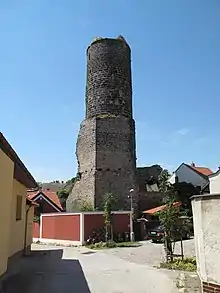
In 1640, during the Thirty Years' War, the castle was burned down by the Swedish army. After the Thirty Years' War, Jenštejn remained for a long time only burnt, ravaged, and empty grunts, according to the Brandýs urbary from 1651 "the Jenštejn fortress ... used to be bricks covered and with few rooms inside. It stands on a rock, around fortress is trench deep fill with water, a wooden bridge was over it, and it is all abandoned and so desolate. (“tvrz Jenštejn ... bývala cihlami přikryta a v ní pokojův nemnoho. Stojí na skále, okolo ní příkop dosti hluboký vodou napuštěný, přes něj býval most dřevěný, a to již všechno zpustlo a tak zpustlé stojí.”)
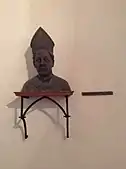
It was abandoned until the end of the 18th century when the castle was once again inhabited by several poor rural families, each family owned one floor. It was settled until the beginning of the 20th century. However, the families often interfered with the interior of the tower, which greatly damaged it. Their interventions were removed during the modern reconstruction. The material of the crumbling castle was also used by the locals to build their houses, which was in the case of abandoned settlements, churches, castle, etc., which is a common affair.
From 2016 until today (2019), the exterior facade of the tower is being preserved under wooden construction.
Type of the castle

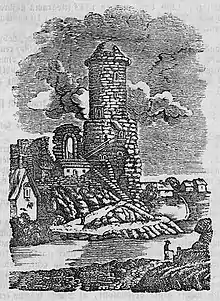
Jenštejn was founded as a water castle in valley on a low sandstone rock. The deep, rock-cut moat could be filled with water from several lakes at Vinoř Creek at any time. Today, the moat is backfilled and built up by recent buildings. We do not know the form or position of the barbican.
An unusual oval shape excelled in the castle's layout and the 28-meter-high tower is the first visible part of the castle. A castle core has a triangular shape.The oldest building structure is located only in a sub-part of Bergfrit and the adjacent part of the wall, which is lined with smaller stones. Three palace wings surrounded the small courtyard. The north disappeared almost without a trace, because the rock below was largely excavated. From the front palace on the east side stood a part of the courtyard wall with arched entrance to the basement. A small fragment of the portal lining in the same wall illustrates the height of the original entrance. The courtyard and parts of the side walls have been preserved from the third palace.[6] The dominant feature of the preserved part of the castle is a 28-meter-high round tower on which are three coats of arms of the owners carved from sandstone are placed at the entrance. On the second floor of the tower is a chapel on a circular ground plan. A wooden spiral staircase leads through the tower. Remains of the circumferential walls of the former palace are preserved in the courtyard. The tower was raised by Jan of Jenštejn, which can be see in follow-up of narrower upper part to the wider lower one. This was used as a walkway for guards, later it was converted to a covered gallery.[5] The original entrance was on the first floor after a drawbridge, but later a new one was created on the ground floor. The tower was covered with a stone helmet with four dormers, the remains of the roofing can be seen on the old engravings (still visible on 19th century engravings).[5]
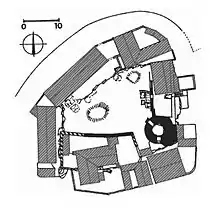
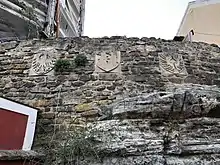
During the reconstruction of Jan of Jenštejn, a private chapel was built on the second floor of the round tower. The circular ground plan of the chapel is vaulted with a ribbed vault with a small smooth bolt in the middle. There is also a small pentagonal presbytery vaulted with a ribbed vault and the same smooth bolt. The presbytery is illuminated by a narrow window with Gothic arch. There is a stone altar with an archbishop's personal coat of arms under the triumphal arch, which has simple geometrically indicated column base on the side of the presbytery. The bust of Archbishop Jan of Jenštejn (the most important owner of the castle) was added after the modern reconstruction into the chapel space. The bust is a replica of the triforium in St. Vitus Cathedral.[5] In the lower part of the tower are cellars, which probably served as pantry and chambers. There are two more floors above the chapel, the first floor can be entered by a narrow spiral staircase. There is usually a small exhibition. Above this floor is unsheltered floor, accessible from ladder used as view point.
Current Restoration 2016 - 2019
The reconstruction is funded by the Ministry of Culture grant and runs only 6 months in a year. The high cost of renting a classic tubular scaffold, which was not financed by the Ministry of Culture, was problematic. Therefore, a type of the wooden scaffolding was paid by the Ministry of Culture of the Czech Republic. The structure is now the property of the village and after the realization period (3 years), there will be a fine quality timber.
The scaffolding also protects neighborhood from the falling parts of the wall, which has been a great danger for the owners of surrounding houses in recent years. Thanks to the scaffolding, a number of mandatory works could be carried out: a restoration works, an operative research by experts from the National Heritage Institute, geodetic research, litological evaluation - (macroscopic stone research by a geologist) and detailed photographic documentation.
The construction of the scaffolding started in December 2015 and was completed in March 2016. The restoration work in this period was limited, it was in fact cleaning of the masonry and execution of sample repairs, but mostly restoration and an operative search.
The scaffolding also includes a tower roofing. This allows work on the remains of the romantic extension, which has long been thought to be the remnant of the original Gothic tower.
Poor condition of the helmet negatively affects the condition of the masonry on the top floor of the tower.
2017
The restoration work consists mainly in the careful removal of incoherent masonry seams, filling deep caverns in the upper tower floors.It will also be important to remove unsuitable artificial substitutes for resin-based stone and replenish these places with stonework.
Today (2019)
The exterior face of the tower is being preserved and reconstruction work will continue when the weather conditions will allowed to do so.
The ruins of the Jenštejn Castle represent historically valuable structure due to the connection of the royal court and the person of Jan of Jenštejn. The reconstruction of the tower is a great chance to correct ill-performed works of past reconstructions and to stop the degradation of stonework, which in a long-term is not tolerable and poses a danger to the structure.[7]
Gallery
 ground plan of the chapel
ground plan of the chapel Presbytery in the chapel with a stone altar decorated with the coat of arms of Jan of Jenštejn
Presbytery in the chapel with a stone altar decorated with the coat of arms of Jan of Jenštejn The rib vault of the presbytery with a smooth keystone
The rib vault of the presbytery with a smooth keystone castle in 1820
castle in 1820 landscape with the castle
landscape with the castle entrance to the castle
entrance to the castle view on castle from the pond area
view on castle from the pond area Connection of the masonry to the tower
Connection of the masonry to the tower
Links
References
- Halada, Jan. (1992–1994). Lexikon české šlechty : erby, fakta, osobnosti, sídla a zajímavosti (in Czech) (1. vyd ed.). Praha: Nakl. Akropolis. ISBN 8090102034. OCLC 28237336.
- "Památkový katalog". pamatkovykatalog.cz (in Czech). Retrieved 2019-04-11.
- Peša, Vladimír. (2002). České hrady : kapesní ilustrovaný průvodce : severní, východní a střední Čechy, Českosaské Švýcarsko, Kladsko (in Czech) (Vyd. 1 ed.). Praha: Argo. ISBN 8072034340. OCLC 85034977.
- Česká republika : stručný turistický pr°uvodce (in Czech). Jánský, Petr. (1. vyd ed.). Cheb: Music Cheb. 2002. ISBN 8085925125. OCLC 608865980.CS1 maint: others (link)
- Pátrová, Karin, 1970- (2013). Hrad Jenštejn (in Czech). Němcová, Andrea, 1971-, Voděra, Kamil, 1968-. V Brandýse nad Labem - Staré Boleslavi: Oblastní muzeum Praha-východ. ISBN 9788090487833. OCLC 852383656.CS1 maint: multiple names: authors list (link)
- Durdík, Tomáš, 1951- (2000). Zříceniny hradů, tvrzí a zámků. Střední Čechy (in Czech). Sušický, Viktor. (Vyd. 1 ed.). Praha: Agentura Pankrác. ISBN 8090287301. OCLC 46964468.CS1 maint: multiple names: authors list (link)
- "Oficiální stránky obce Jenštejn - Obec". www.jenstejn.cz (in Czech). Retrieved 2019-04-11.
Literature
- DURDÍK, Tomáš. Ilustrovaná encyklopedie českých hradů. Praha: Libri, 2002. 736 s. ISBN 80-7277-003-9. Heslo Jenštejn, s. 225–226. (in Czech)
- PÁTROVÁ, Karin; NĚMCOVÁ, Andrea. Hrad Jencestein. Brandýs nad Labem: Oblastní muzeum Praha-východ, 2013. ISBN 978-80-904878-3-3. (in Czech)
- MIKOVEC, Ferdinand Břetislav. Starožitnosti a Památky země České.. Ilustrace Josef Vojtěch Hellich, Vilém Kandler. Praha: Kober a Markgraf, [1860]. Dostupné online. Kapitola Zříceniny hradu Jenštejna, s. 46–51. (in Czech)
- SEDLÁČEK, August. Hrady, zámky a tvrze Království českého: Kouřimsko. Svazek XV. Praha: Jiří Čížek – ViGo agency, 2000. 306 s. Kapitola Jenštejn hrad, s. 160–163. (in Czech)
- ŠITTLER, Eduard; PODLAHA, Antonín. Soupis památek historických a uměleckých v politickém okresu Karlínském. Praha: Archeologická komise při České Akademii císaře Františka Josefa pro vědy, slovesnost a umění, 1901. Dostupné online. Kapitola = 96420&mcp = &s = jpg&author = Jenštýn, s. 193–197. (in Czech)
- Jenstein – burg. Soupis památek, 15. Der politische Bezirk Karolinenthal. 1903, roč. 15, s. 209–213. Dostupné online [cit. 2015-06-14]. (in German)
External links
| Wikimedia Commons has media related to Jenštejn Castle. |
- https://www.jenstejn.cz/ (in Czech)
- https://brandys.muzeumbrandys.cz/en/jenstejn-castle-ruins (in Czech)
- https://www.hrady.cz/index.php?OID=166 (in Czech)
- https://www.fa.cvut.cz/galerie/diplomove-prace/2011-1-kopecky-soucasna-vesnice-jenstejn-4fc4e7f25016536c00094763/kopeckyjan_portfolio.pdf (in Czech)
- cs:Jenštejn (hrad) (in Czech)
- Infoglobe: CZ: Jenštejn - Black Ruins Of The Castle Tower (in English)